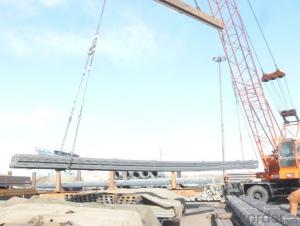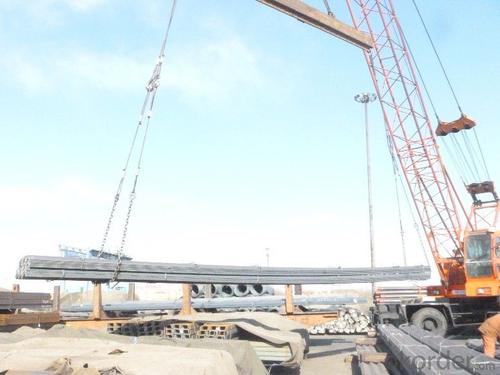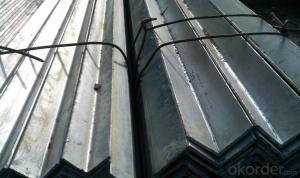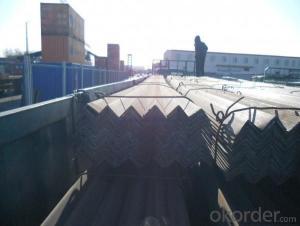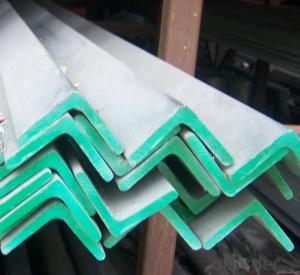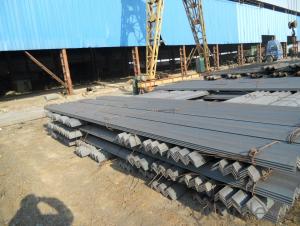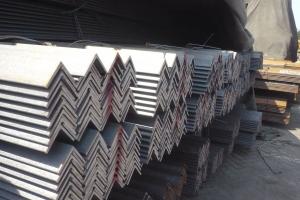Angle steel; steel angle for sale
- Loading Port:
- Shanghai
- Payment Terms:
- TT OR LC
- Min Order Qty:
- 25 m.t.
- Supply Capability:
- 10000 m.t./month
OKorder Service Pledge
OKorder Financial Service
You Might Also Like
Specifications of Angle Steel
1. Invoicing on theoretical weight or actual weight as customer request
2. Length: 6m, 9m, 12m as following table
3. Sizes
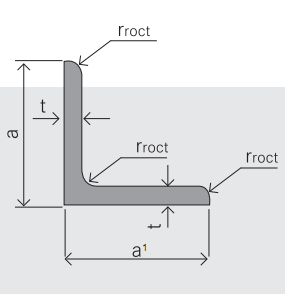
Sizes: 25mm-250mm | ||
a*t | ||
25*2.5-4.0 | 70*6.0-9.0 | 130*9.0-15 |
30*2.5-6.6 | 75*6.0-9.0 | 140*10-14 |
36*3.0-5.0 | 80*5.0-10 | 150*10-20 |
38*2.3-6.0 | 90*7.0-10 | 160*10-16 |
40*3.0-5.0 | 100*6.0-12 | 175*12-15 |
45*4.0-6.0 | 110*8.0-10 | 180*12-18 |
50*4.0-6.0 | 120*6.0-15 | 200*14-25 |
60*4.0-8.0 | 125*8.0-14 | 250*25 |
5. Payment terms:
1).100% irrevocable L/C at sight.
2).30% T/T prepaid and the balance against the copy of B/L.
3).30% T/T prepaid and the balance against L/C
6.Material details:
Alloy No | Grade | Element (%) | |||||
C | Mn | S | P | Si | |||
|
|
|
|
|
|
| |
Q235 | B | 0.12—0.20 | 0.3—0.7 | ≤0.045 | ≤0.045 | ≤0.3 | |
|
|
|
|
|
|
| |
Alloy No | Grade | Yielding strength point( Mpa) | |||||
Thickness (mm) | |||||||
≤16 | >16--40 | >40--60 | >60--100 | ||||
≥ | |||||||
|
|
|
|
|
| ||
Q235 | B | 235 | 225 | 215 | 205 | ||
Alloy No | Grade | Tensile strength (Mpa) | Elongation after fracture (%) | ||||
Thickness (mm) | |||||||
| ≤16 | >16--40 | >40--60 | >60--100 | |||
≥ | |||||||
|
|
|
|
|
|
| |
Q235 | B | 375--500 | 26 | 25 | 24 | 23 | |
Usage & Applications of Angle Steel
According to the needs of different structures, Angle can compose to different force support component, and also can be the connections between components. It is widely used in various building structures and engineering structures such as roof beams, bridges, transmission towers, hoisting machinery and transport machinery, ships, industrial furnaces, reaction tower, container frame and warehouse etc.
Packaging & Delivery of Angle Steel
1. Packing: it is nude packed in bundles by steel wire rod
2. Bundle weight: not more than 3.5MT for bulk vessel; less than 3 MT for container load
3. Marks:
Color marking: There will be color marking on both end of the bundle for the cargo delivered by bulk vessel. That makes it easily to distinguish at the destination port.
Tag mark: there will be tag mark tied up on the bundles. The information usually including supplier logo and name, product name, made in China, shipping marks and other information request by the customer.
If loading by container the marking is not needed, but we will prepare it as customer request.
Production flow of Angle Steel
Material prepare (billet) —heat up—rough rolling—precision rolling—cooling—packing—storage and transportation
- Q: How do steel angles compare to other structural materials?
- Due to their versatility and strength, steel angles are widely favored in the construction industry. In comparison with alternative structural materials like wood or aluminum, steel angles present several benefits. To begin with, steel angles possess exceptional strength and load-bearing capacity. They are capable of supporting heavy loads and ensuring structural stability, making them ideal for implementation in infrastructure projects such as buildings and bridges. Furthermore, steel angles exhibit a high resistance to bending and twisting, guaranteeing durability and longevity across various applications. Moreover, steel angles offer remarkable versatility. They can be easily customized and fabricated into different shapes and sizes, facilitating precise and efficient construction. This flexibility empowers designers and engineers to create intricate structures and achieve specific architectural requirements. Additionally, steel angles provide outstanding fire resistance compared to materials like wood. Steel is non-combustible, meaning it does not contribute to the spread of fire, thereby rendering it a safer option for buildings and structures. Furthermore, steel angles boast a high rate of recyclability, making them environmentally friendly. Steel stands as one of the most recycled materials globally, and implementing steel angles in construction contributes to sustainable building practices while reducing the demand for fresh raw materials. Nevertheless, it should be noted that steel angles can be pricier than certain alternative materials like wood or aluminum. Furthermore, steel necessitates appropriate surface treatment and corrosion protection to prevent rusting and maintain its structural integrity. In conclusion, steel angles present numerous advantages over alternative structural materials, including superior strength, versatility, fire resistance, and recyclability. These characteristics establish them as a favored choice in numerous construction projects where durability, efficiency, and safety hold utmost importance.
- Q: What is the maximum length of a steel angle that can be transported?
- The transportation of steel angles is subject to various factors, including transportation regulations, the size and capacity of the transport vehicle, and logistical constraints. The maximum length of a steel angle that can be transported is influenced by these factors. Typically, standard transport vehicles such as trucks or trailers can transport steel angles up to approximately 40 feet (12.2 meters). However, the length of cargo that these vehicles can carry might be limited due to road transportation regulations or physical limitations. Specialized transport options, such as flatbed trucks or lowboy trailers, can be utilized to accommodate longer steel angles. These vehicles are specifically designed to carry oversized or heavy loads and may have extended cargo beds or adjustable trailers to accommodate longer lengths. The maximum length of a steel angle that can be transported varies depending on the specific circumstances and available transport options. To determine the most suitable means of transporting steel angles of different lengths, it is advisable to consult with transportation professionals or logistics experts.
- Q: What is the maximum allowable torsional lateral-torsional buckling stress for a steel angle?
- The maximum torsional lateral-torsional buckling stress allowed for a steel angle relies on several factors, including the angle's material properties, dimensions, and the applicable design code or specific usage. In general, the maximum stress allowed for torsional lateral-torsional buckling is determined by assessing the critical load at which the angle would buckle due to combined torsional and lateral loads. This buckling mode occurs when the angle experiences both torsional twisting and lateral deflection simultaneously, resulting in instability. Engineers typically employ various formulas and design codes specific to the application to calculate the maximum allowable stress. These formulas take into account the angle's moment of inertia, cross-sectional dimensions, slenderness ratio, and other geometric properties. It is important to acknowledge that the maximum allowable torsional lateral-torsional buckling stress for a steel angle can differ depending on the design code followed. Design codes such as the AISC Steel Construction Manual or the Eurocode offer guidelines and equations for determining the maximum allowable stress for different types of steel angles. As a result, to ascertain the specific maximum allowable torsional lateral-torsional buckling stress for a steel angle, it is necessary to refer to the relevant design code or seek assistance from a qualified structural engineer.
- Q: How do you calculate the moment resistance of a steel angle?
- In order to determine the moment resistance of a steel angle, one must take into account the angle's geometry and material properties. The moment resistance refers to the angle's capacity to withstand bending forces. Initially, the section modulus must be calculated, which measures the shape's resistance to bending. The section modulus is obtained by dividing the angle's moment of inertia (I) by the distance from the shape's centroid to the farthest point (c). Subsequently, the yield strength of the steel angle needs to be determined. This is the point at which the material begins to permanently deform. The yield strength is typically provided by the manufacturer or can be acquired through material testing. Lastly, the moment resistance can be calculated by multiplying the section modulus (Z) by the yield strength (σ). This calculation yields the maximum moment that the steel angle can withstand before permanent deformation occurs. Moment Resistance = Z * σ It is important to note that this calculation assumes that the steel angle is solely subjected to bending. If there are additional factors present, such as axial or shear forces, further calculations or considerations may be necessary. Furthermore, it is always advisable to consult relevant design codes or engineering handbooks for more precise and detailed calculations.
- Q: What are the different types of surface defects in steel angles?
- There are several different types of surface defects that can occur in steel angles. These defects can affect the appearance, strength, and overall quality of the steel. Some common types of surface defects in steel angles include: 1. Scale: Scale refers to the formation of a thin layer of iron oxide on the surface of the steel. It is commonly caused by the exposure of the steel to high temperatures during manufacturing or processing. Scale can affect the appearance of the steel and can also lead to corrosion if not removed. 2. Pits: Pits are small depressions or cavities on the surface of the steel. They can be caused by a variety of factors, including corrosion, improper handling, or manufacturing defects. Pits can weaken the steel and reduce its overall strength. 3. Scratches: Scratches are grooves or marks on the surface of the steel caused by abrasion or contact with other objects. While scratches may not affect the structural integrity of the steel, they can impact its appearance and may provide a starting point for corrosion. 4. Inclusions: Inclusions are non-metallic particles or impurities that are trapped within the steel during the manufacturing process. They can be caused by a variety of factors, such as improper steelmaking techniques or the presence of foreign materials. Inclusions can weaken the steel, leading to reduced strength and potential failure under load. 5. Laminations: Laminations are layers or sheets of metal that are not properly bonded together during the manufacturing process. They can occur due to improper rolling or welding techniques. Laminations can weaken the steel, reducing its strength and potentially causing failure. 6. Corrosion: Corrosion is a chemical reaction that occurs when steel is exposed to moisture and oxygen. It can result in the formation of rust or other corrosion products on the surface of the steel. Corrosion can weaken the steel and reduce its overall integrity. It is important to identify and address these surface defects in steel angles to ensure the quality and performance of the steel. Regular inspection, proper handling, and appropriate surface treatment can help minimize the occurrence and impact of these defects.
- Q: What is the typical thickness of the legs of a steel angle?
- The typical thickness of the legs of a steel angle can vary depending on the specific application and requirements. However, in general, steel angles are available in a wide range of standard thicknesses, commonly ranging from 1/8 inch to 1 inch. The thickness of the legs of a steel angle is typically uniform, meaning both legs will have the same thickness. It is important to note that for specialized or custom applications, thicker or thinner legs can be manufactured to meet specific needs. Consulting engineering specifications or industry standards can provide more precise information on the typical thickness of steel angle legs for specific applications.
- Q: Can steel angles be used for platform structures?
- Yes, steel angles can be used for platform structures. Steel angles are commonly used in construction for their strength and stability. They provide structural support and can be used to create a sturdy and reliable platform structure.
- Q: What are the different types of steel angles connections for mezzanine floors?
- There are several different types of steel angle connections that can be used for mezzanine floors. These connections are designed to provide structural stability and support for the floor, ensuring that it can safely accommodate the intended loads and usage. 1. Bolted Connections: Bolted connections are commonly used in mezzanine floors as they offer a strong and secure connection. These connections involve using bolts to attach the steel angles together, creating a rigid and stable framework. Bolted connections can be easily adjusted or disassembled if required. 2. Welded Connections: Welded connections involve joining the steel angles using welding techniques. This type of connection provides a permanent and strong bond between the angles, ensuring maximum stability. Welded connections are often preferred for heavy-duty mezzanine floors where high load-bearing capacity is required. 3. Clip Connections: Clip connections are a popular choice for mezzanine floors as they offer ease of installation and flexibility. These connections involve using metal clips or brackets to secure the steel angles together. Clip connections can be easily adjusted or disassembled, allowing for future modifications or reconfigurations of the mezzanine floor layout. 4. Gusset Plate Connections: Gusset plate connections involve using additional steel plates, known as gusset plates, to reinforce the joint between the steel angles. These plates are typically welded or bolted to the angles, providing added strength and stability to the connection. Gusset plate connections are commonly used in mezzanine floors where extra reinforcement is necessary. 5. Cleat Connections: Cleat connections involve using a cleat plate to connect two steel angles. The cleat plate is attached to one angle, while the other angle is bolted or welded to the plate. This type of connection provides a strong and secure joint, particularly when used with heavy-duty mezzanine floors. It is essential to ensure that the chosen steel angle connections for mezzanine floors are in compliance with local building codes and regulations. Additionally, consulting a structural engineer or a professional with expertise in mezzanine floor construction is recommended to ensure the connections are designed and installed correctly for optimal safety and performance.
- Q: How do you prevent welding distortion in steel angles?
- There are several ways to prevent welding distortion in steel angles. One common method is to use tack welds to hold the pieces in place before making the final welds. This helps to distribute the heat more evenly and reduce the chances of distortion. Additionally, using a smaller welding electrode or reducing the welding current can also help minimize distortion. Another technique is to weld in a staggered pattern, alternating between the top and bottom sides of the angle, which can help to balance the thermal effects. Lastly, controlling the preheating and cooling rates, as well as implementing proper welding sequence and clamping techniques, can further reduce welding distortion in steel angles.
- Q: What are the different methods of surface preparation for steel angles before painting?
- There are several methods of surface preparation for steel angles before painting. The choice of method depends on the condition of the steel surface and the desired level of paint adhesion and durability. One common method is abrasive blasting, also known as sandblasting. This involves propelling abrasive particles against the steel surface to remove rust, mill scale, and other contaminants. Abrasive blasting not only cleans the surface but also creates a rough profile, which improves the adhesion of the paint. Chemical cleaning is another method used to prepare steel angles for painting. It involves the use of chemical solutions or solvents to remove grease, oil, and other organic contaminants. This method is particularly useful for removing stubborn contaminants that cannot be removed by abrasive blasting alone. Mechanical cleaning methods, such as wire brushing or grinding, can be used to remove loose rust, scale, and old paint. These methods are suitable for smaller areas or localized rust spots. In some cases, power tool cleaning may be sufficient. This involves using power tools such as grinders, sanders, or wire brushes to clean the steel surface. However, it is important to ensure that these tools do not create a polished or smooth surface, as this can reduce paint adhesion. After the surface has been cleaned, it is important to remove any residual contaminants by using a solvent wipe or a clean cloth soaked in a suitable solvent. This step ensures that the surface is free from any remaining contaminants that could affect the paint adhesion. Finally, the steel angles should be primed before painting. A primer provides additional corrosion protection and enhances the adhesion of the topcoat. The choice of primer depends on the specific requirements of the project, such as exposure to harsh weather conditions or chemical exposure. Overall, the different methods of surface preparation for steel angles before painting include abrasive blasting, chemical cleaning, mechanical cleaning, power tool cleaning, solvent wiping, and priming. Selecting the appropriate method ensures that the paint adheres well to the steel surface and provides long-lasting protection against corrosion.
Send your message to us
Angle steel; steel angle for sale
- Loading Port:
- Shanghai
- Payment Terms:
- TT OR LC
- Min Order Qty:
- 25 m.t.
- Supply Capability:
- 10000 m.t./month
OKorder Service Pledge
OKorder Financial Service
Similar products
Hot products
Hot Searches
Related keywords
